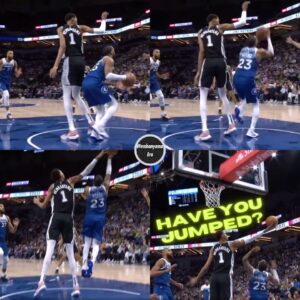In case you missed it — and, honestly, how could you have? — reigning MVP Joel Embiid scored a career-high, NBA season-high and 76ers franchise-record 70 points last Monday. About an hour after the final buzzer of Philly’s win over the Spurs, Karl-Anthony Towns finished with a career-high and Timberwolves franchise-record 62 points (albeit in a loss).
Last Friday saw another two-fer: Devin Booker popping off for 62 of his own (albeit in a loss), while Luka Dončić ensured that Embiid’s reign on the top of the season-scoring mountain was short like leprechauns by pouring in 73 to beat the Hawks.
The entire 2022-23 NBA season produced four 60-plus-point performances; we just had four in a span of four days. That concentration of ludicrous point production has prompted no shortage of chatter around the league about the state of play in the NBA, much of it centered on a pair of questions: If, as the adage goes, one’s a fluke, two’s a coincidence, and three’s a trend … well, is four a problem? And, if so, what’s the solution?
Last week’s scoring explosions come in the context of a league-wide rising tide in gaudy numbers that’s been swelling for years.
In the history of the NBA, only 19 seasons have featured 10 or more 50-point scoring performances; the last nine, from 2015-16 to the present, account for nearly half of that list. Only 10 campaigns have featured 14 or more; the last five, from 2018-19 to today, comprise half of that list … and 2023-24 is already at 13, and it’s not even the All-Star break.
The Hawks had no answer for Luka Dončić on Friday night. (Photo by Todd Kirkland/Getty Images)
So: Why are we seeing so many crooked numbers? As satisfying as it would be to say, “It is simply because These Dudes Don’t Guard and too few players Have That Dog In Them,” and then slam closed your Very Heavy Book of Takes, the answer is, regrettably, probably a bit more complicated than that.
One factor? An increased commitment to hitting the gas. According to Basketball-Reference.com, NBA teams are averaging 99.2 possessions per 48 minutes this season — the ninth straight season in which the average “pace factor” has been over 95. The last time the pace had been that high before this stretch: 1993-94, the end of an era marked by run-and-gun outfits like Don Nelson’s Run-TMC Warriors and Doug Moe’s “passing game” Nuggets, as well as fast-breaking classics like the legendary Showtime Lakers.
At the risk of oversimplifying, more offensive possessions means more opportunities for players to score. Today’s stars take full advantage of those chances, thanks in part to another factor in these scoring surges: the rise in prominence of the 3-point shot.
Back in 1987-88, when Magic Johnson’s freewheeling Lakers won their fifth title in nine seasons, the 3-pointer was still more or less a novelty. The NBA leaders in long-distance attempts, the Celtics, hoisted a whopping 8.6 per game; league-wide, triple tries accounted for just 5.7% of teams’ field-goal attempts. These days, the league-average 3-point attempt rate is all the way up to 39.2%. And that’s the average: 10 teams are taking more than 40% of their shots from downtown, topped by, coincidentally, the Celtics at 47.2%.
Whether you attribute that dramatic shift in the league’s overall shot profile to the strategic influence of the early 2010s Houston Rockets on a league that would become Moreypilled by the knowledge that 3 is more than 2, to the landfall of a sub-orbital meteor named Stephen Curry who would rearrange the landscape of the league in his own image, or to a bit of both, the impact is undeniable. It’s also, y’know, visible.
For example: Check out how the floor looked as Kobe Bryant rose up from the baseline early in the third quarter on the night he’d finish with 81 …
(NBA video screenshot)
… and compare it to this shot of Luka rising up early in his 73-point evening:
(NBA video screenshot)
Back in 2006, you had seven players in the paint, Kobe pulling up and Chris Bosh contesting the jumper — 90% of the players in the game dogpiling within 10 feet of the basket. (The lone exception: Smush Parker, off screen, rotating back on transition defense. Shout out to a fundamental king.)
Compared to that sort of gridlock, a contemporary playmaker like Dončić — with shooters in the corners, another spotting up several steps beyond the arc in the slot, and a screener rolling to draw a defender to the rim — gets a pleasure cruise down the expressway before rush hour, with a decadent amount of opportunity to change lanes and angles of approach whenever it suits him. Particularly in a league that made a deliberate shift a half-decade ago to emphasize greater freedom of movement for offensive players, aiming to bolster offense by cutting down on hand-checking, clutching and grabbing on the perimeter — which, necessarily, made life a hell of a lot harder on defenders.
“Generally, when you look at some of these really, really explosive individual performances where guys have put up huge numbers, I think you can immediately look at the free-throw line. There’s always a correlation,” Bulls head coach Billy Donovan said last season. “The free throw and the fouling has become a real challenge, because the minute you get your hands on people, those elite scorers know how to manipulate and draw fouls.”
Embiid, who leads the NBA in free-throw attempts per game, shot 23 freebies in his 70-point game, making 21. Dončić went 15-for-16. Towns went 10-for-14; Booker, 12-for-13.
As writers like Mike Prada, Seth Partnow and Kirk Goldsberry, among others, have explored, these factors have all intermingled to drive the spike in offensive efficiency that has produced both outsized individual performances like last week’s quartet and some of the most potent team attacks in NBA history. (As Matt Moore of The Action Network notes, virtually the entirety of the league’s all-time single-season offensive rating leaderboard comes from the last handful of seasons.) A greater emphasis on the importance of the 3-point shot — and specifically the higher-valued corner 3-pointer, which is worth the same number of points despite being nearly two feet closer to the rim than the above-the-break 3 — means skill development aimed at ensuring players can shoot it. In the season when Kobe scored 81, there were six players who shot more than six 3-pointers per game; this year, there are 52.
More players who can shoot it — and more power forwards and centers who can shoot it, specifically — means more space that defenses have to cover. Stretch the defense out and draw those defensive bigs out of the paint to the perimeter, and you’ve got more driving lanes, more opportunities to get downhill and a better shot at scoring in a decongested lane. In 2005-06, the average team shot 60.1% within 3 feet of the basket. This year: 69.4%.
As my colleague Ben Rohrbach wrote last season, the revolution that Steph and the Moreyball Rockets and Co. ushered in has resulted in a generation of players who “have all but perfected the game’s most efficient shots and dialed up their volume from each location to 11.” And when those players hit those shots at an elite level … while also repeatedly baiting defenders into contact that gets them to the charity stripe (or benefiting from the room defenders have to give them lest they get too physical and catch a freedom-of-movement whistle) … and while raining fire from midrange (where Luka, Embiid, Towns and Booker all shoot 49% or better) … then you’ve got a recipe for some historic nights for the offense.
Especially when those offenses run into already bad defenses. Like, for example, the Hawks, Spurs, Pacers and Hornets — against whom this season’s five 60-point games have come, and all of whom rank 25th or worse in points allowed per possession.
This isn’t the first time in league history that remarkably skilled and physically gifted players have put up outlandish numbers. As Tom Haberstroh of The Finder notes, if you’re looking for a “juiced ball” era in the NBA, you’d be better served looking backward about six decades to the early 1960s, where an even faster pace of play than we’ve got today — nearly 130 possessions per game — created even more opportunities for accumulation, leading to some of the eye-popping numbers that greats like Elgin Baylor, Oscar Robertson and especially Wilt Chamberlain posted, and that still turn up as reference points every time a modern player goes nuclear.
In response to that dominance — and specifically Wilt’s dominance — the league widened the lane in 1964, from 12 feet to 16 feet, in an attempt to better balance the game between bigs and smalls, offense and defense. There are plenty of folks who’d like to see similarly styled mitigation efforts implemented today — including the coaches whose job it is to figure out how to stop all those points from continuing to pile up.
“The way we officiate the game favors the offense in a way that it didn’t 15 years ago,” Warriors coach Steve Kerr recently told reporters. “The rules have been altered to really give the benefit of the doubt to the offensive player. I think we’re actually entering a phase now where we’re going to have to look at — just like the league did 20 years ago — look at the rules, see where the game is going and maybe make some adjustments back in the other direction.”
Thus far, though, that’s not a direction that NBA commissioner Adam Silver and the powers-that-be in the Board of Governors have seemed interested in going, preferring instead to lean in the direction of the buckets that bring the highlights that bring the eyeballs that bring the billions from broadcast partners. And barring a dramatic shift the other way — being more liberal in letting defenders get physical, pushing back the 3-point line, eliminating the corner 3, getting rid of defensive three seconds rules that prevent a big man from camping in the paint, etc. — it seems likely that those buckets, and the shockingly big nights they lead to, will keep on coming.





